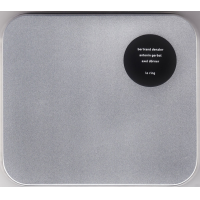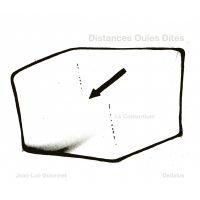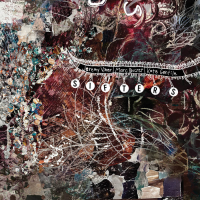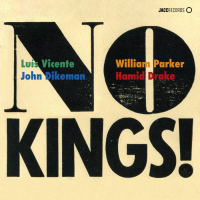Home » Jazz Articles » Multiple Reviews » Three saxophonists' very different paths since "Propagations"
Three saxophonists' very different paths since "Propagations"
Disappointingly, despite the album's musical and critical success, the four have not recorded together again since, but have gone their separate ways. They have become stalwarts of the Potlatch label, with about half of the label's releases since Propagations featuring one or more of the four. In that time, their paths have diverged so much that it seems unlikely they will reconvene as a quartet, a point that was eloquently illustrated by these recordings including Baron, Denzler and Guionnet, coincidentally released within months of each other...
 Marc Baron
Marc Baron Un salon au fond d'un lac
Potlatch
2016
Following in the footsteps of Hidden Tapes (Potlatch, 2014), Baron's intriguing first outing as a composer rather than a saxophonist, Un salon au fond d'un lac is rather more varied and focussed. Where Hidden Tapes was centred around the content of old cassette tapes—dating from 1965 through to 2013—augmented by the addition of music and sounds from other sources, this time out the balance has shifted in favour of the latter.
This album consists of three tracks, totalling thirty-five minutes, two of about sixteen minutes each, with a far shorter one sandwiched in between them. The style of the longer tracks, "Un Salon" and "Un Lac," is recognisably Baron—multi-layered pieces that create their own distinctive mood, revealing more detail with every hearing. Although human beings are skilled at imposing meaning on random phenomena (seeing the face of the Virgin Mary in a passing cloud, or Elvis's profile in a burnt pancake...) these tracks have no obvious narrative thread and so rely on each listener's personal interpretation.
The tracks frequently juxtapose contrasting passages to emphasise their differences—for example, glitchy electronic sounds and a child's laughter (As before, the latter sound can make one feel uneasily like an eavesdropper, but less so than on Hidden Tapes, thankfully.) Occasionally, a promising passage seems to end prematurely while another outstays its welcome, but such judgments will vary from individual to individual.
Strangely, the most engaging track here is also the shortest, "La Structure," which clocks in at three-and-a-half minutes. It consists of a lone voice—Baron, no doubt—reciting decimal numbers (one point one, one point two...) which gradually morph into a cacophonous cut-up collage form that makes their content both unintelligible and compelling. That track gives a glimpse of an avenue that Baron should consider pursuing further in future. Certain passages of the two longer tracks would have been promising raw material for similar treatment. Overall, as was true of Hidden Tapes, Baron's work remains personal, idiosyncratic and endlessly fascinating.
 Bertrand Denzler / Antonin Gerbal / Axel Dörner
Bertrand Denzler / Antonin Gerbal / Axel Dörner Le Ring
Confront
2016
Although Bertrand Denzler has featured frequently on Potlatch, notably in Trio Sowari, with Phil Durrant and Burkhard Beins, and on his remarkable solo album Tenor (Potlatch, 2010), he frequently appears on other labels in a variety of guises, including the fine ensembles Hubbub on Matchless, Zoor on Umlaut, Horns and ONCEIM, both on Confront.
So it is no surprise to find Le Ring on Confront, featuring the threesome of Denzler on tenor saxophone, Axel Dörner on trumpet and Antonin Gerbal on drums who played their first concert together in March 2015. Given music's vast Venn diagram of overlapping ensembles, this trio is hardly new, as the three already knew each other, Denzler and Gerbal from ONCEIM, Zoor and playing as a duo, Dörner and Gerbal from Peeping Tom, with Denzler and Dörner having first played together in 2001.
The music here consists of a single forty-one-minute track, recorded live during Festival Noise #5, in December 2015, in Toulouse. As so often happens, their mutual familiarity allows the three to get straight into playing together easily and naturally. Opening with a sequence of sustained notes on trumpet and saxophone, Dörner and Bertrand react to one another without any rush, each giving the other space and, in typical fashion, savouring every note to its end. They each produce an impressive variety of sounds, from under blown and breathy through to full blow and high pitched.
Whether he is supporting the horns or—as on his impressive solo album Sound of Drums (Umlaut, 2016)—in the spotlight himself, credit must go to Gerbal, whose percussion acts as the glue that holds everything together, making the music flow. Together, the three combine to give an enthralling performance full of peaks, troughs and climaxes, displaying the knack of building tension and releasing it at just the right moment.
 Jean-Luc Guionnet / Dedalus
Jean-Luc Guionnet / Dedalus Distances Ouïes Dites
Potlatch
2016
As well as being Denzler's saxophone partner in Hubbub since 1999, over two decades Jean-Luc Guionnet has built up an impressive discography involving numerous collaborations on a range of labels. In addition to playing alto saxophone, recorder, electronics and organ, he has also frequently been credited with photography or graphic design. His last Potlatch release was the boldly experimental four-disc set Home, with his frequent collaborator Eric La Casa, which was based on field-recorded interviews with four Glaswegians in their homes.
With Distances Ouïes Dites, Guionnet has pushed his frontiers further, producing a work that is just as experimental and enthralling. It records a March 2013 concert in which the seven-piece Dedalus Ensemble gave a performance of the scored Guionnet title composition at Le Consortium art centre in Dijon. But, being Guionnet, things were not as simple or straightforward as that makes them sound! In Le Consortium, the audience was in one room with viola player Cyprien Busolini while the other six musicians were located elsewhere, each in a separate room. (To those who have seen it, that set-up may sound similar to Icelander Ragnar Kjartansson's nine-screen video work The Visitors which has been touring world art galleries, in which nine musicians perform a sixty-four-minute piece together, located in different rooms of a run-down mansion in upstate New York. The big difference is that Kjartansson's musicians could hear each other via headphones while Guionnet's could not...)
So, the score and the musicians had to take account of such complex factors as the sonic characteristics of the different rooms, the distances between instruments and the audience and the time for sounds to travel between them. If all that conjures up visions of a nightmare for the musicians and audience to cope with, the recording bears no evidence of anyone struggling with the situation, and the music sounds as coherent and fluent as if the ensemble and audience were all together in one room. The septet's instrumentation of strings, electric guitar, voice and brass provides great scope for variety and contrasts which Guionnet exploited to the full. Across fifteen tracks, varying in length from thirty-seven seconds to seven minutes, the composition's twenty-one sections cover a broad spectrum of styles that are integrated together into a kaleidoscopic whole that flows easily without any disconcerting jump cuts or non-sequiturs.
Throughout, there is a feeling that the musicians are not just playing in the space but also playing with it, in both senses of that phrase; firstly, they are toying with it in order to discover its acoustic properties and, secondly, the space acts as an eighth ensemble member, shaping the music in its own ways whether that music is a drone, melodic interlude, percussive passage, quiet reflective section or a tutti.
The album's fifty-two minutes guarantee a fulfilling and pleasurable experience, time after time, one that demands to be repeated frequently.
Tracks and Personnel
Un salon au fond d'un lac
Tracks: Un Salon; La Structure; Un Lac.
Personnel: Marc Baron: analogue reel-to-reel tape manipulation.
Le Ring
Tracks: Le Ring.
Personnel: Bertrand Denzler: tenor saxophone; Antonin Gerbal: percussion: Axel Dörner: trumpet.
Distances Ouïes Dites
Tracks: Combinatoire I & II; Signal/Bruit; Mixage combinatoire; Mélodie I—Influence par le lointain; Propagation en tirets des ondes stationnaires—Du lointain au proche; Faire mentir l'aphorisme: La proximité ne prouve rien; Mémoire vive; Hauteurs sous plafond; Dans l'espace mental—Arpenter les salles; Entrée des ondes stationnaires subjectives; Mélodie II—Influence par le proche; Mélodie III—Influence par le milieu; Faire mentir l'aphorisme: Lointain, mêle pire est beau quand on l'écoute; Propagation continue des ondes stationnaires—Du proche au lointain.
Personnel: Cyprien Busolini: viola; Deborah Walker: cello; Vincent Bouchot: voice; Eric Chalan: double-bass; Christian Pruvost: trumpet; Thierry Madiot: trombone; Didier Aschour: electric guitar.
Tags
Multiple Reviews
John Eyles
France
Paris
Marc Baron
Bertrand Denzler
Jean-Luc Guionnet
Potlatch
Confront
PREVIOUS / NEXT
Support All About Jazz
 All About Jazz has been a pillar of jazz since 1995, championing it as an art form and, more importantly, supporting the musicians who make it. Our enduring commitment has made "AAJ" one of the most culturally important websites of its kind, read by hundreds of thousands of fans, musicians and industry figures every month.
All About Jazz has been a pillar of jazz since 1995, championing it as an art form and, more importantly, supporting the musicians who make it. Our enduring commitment has made "AAJ" one of the most culturally important websites of its kind, read by hundreds of thousands of fans, musicians and industry figures every month.



















